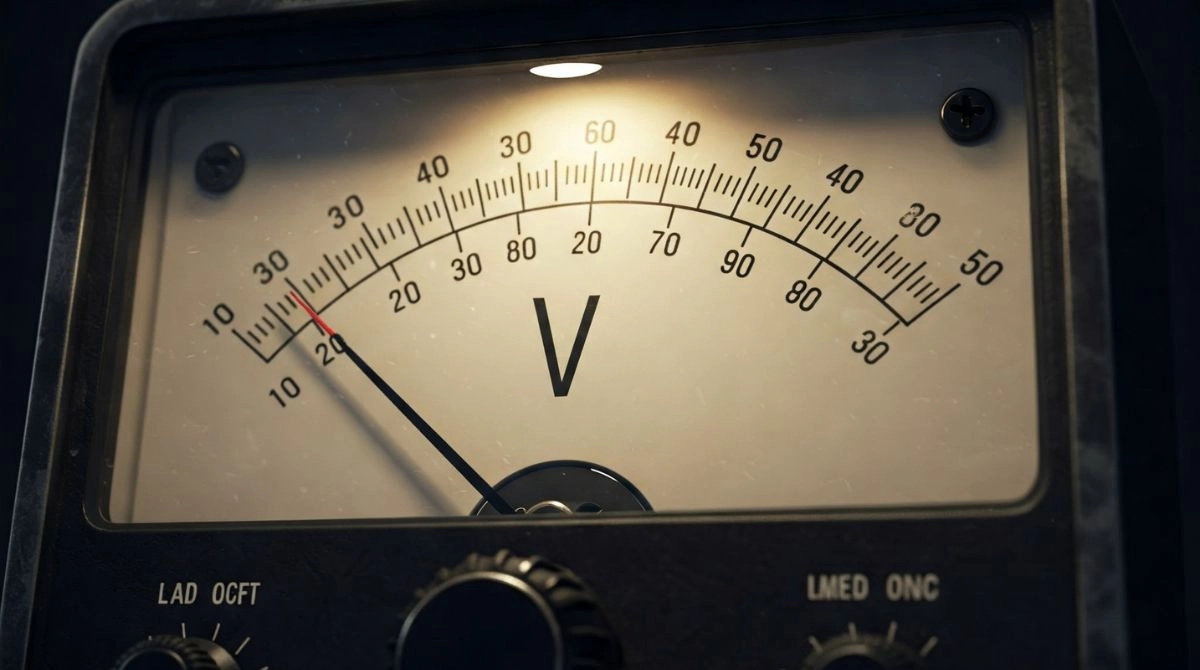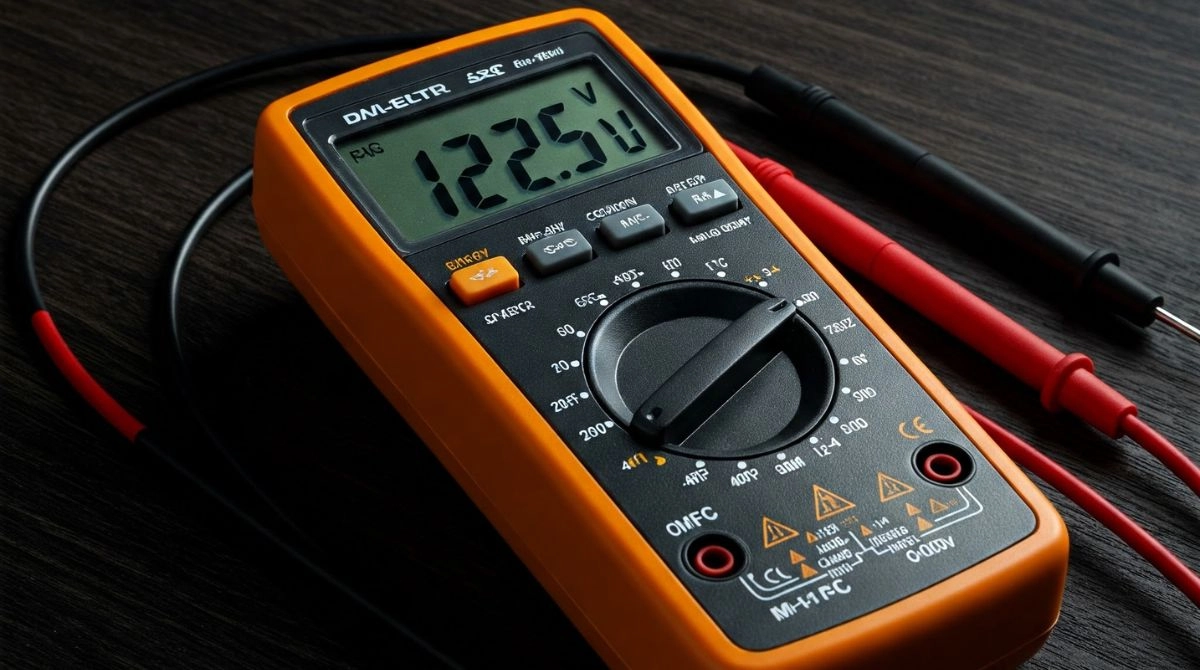Introduction
Have you ever wondered how to check if a battery still has life in it or if your home outlet is delivering the right amount of electricity? That’s where a voltmeter comes in handy. Whether you’re a curious diyer, an electronics student, or just someone who wants to understand their gadgets a little better, learning how to use a voltmeter is a simple and rewarding skill.
What Is a Voltmeter?
The Basics: A Tool for Measuring Voltage
A voltmeter is a device that measures the electrical potential difference also known as voltage between two points in a circuit. Voltage is like the “push” that makes electricity flow, measured in volts (V). Think of it as the pressure in a water pipe: the higher the pressure, the faster the water moves. Similarly, voltage drives the current through a circuit.
Voltmeters are essential because they help you check if a circuit has the right amount of “push” to work properly. For example, a car battery should have around 12 volts when fully charged. If your voltmeter shows a much lower reading, you know something’s wrong.
Why Is It Called a Voltmeter?
The name “voltmeter” comes from “volt,” the unit of voltage, and “meter,” which means a device that measures something. Simple, right? It’s designed to be connected in parallel to a circuit (more on that later), and it has a very high internal resistance to ensure it doesn’t interfere with the circuit’s operation. An ideal voltmeter has infinite resistance, meaning it draws almost no current while measuring.
Types of Voltmeters: Which One Is Right for You
It come in different flavors, each suited for specific tasks. Let’s break down the most common types you’ll come across.
Analog Voltmeters: The Classic Choice
- How They Work: Analog voltmeters have a needle that moves across a scale to show the voltage. They’re old-school but still used in some settings because they don’t need batteries for basic operation.
- Best For: Vintage electronics, educational purposes, or situations where you need a quick visual reading without digital precision.
- Example: Imagine you’re restoring an old radio. An analog voltmeter can help you check the voltage across the tubes to ensure they’re getting the right power.
Digital Voltmeters: Modern and Precise
- How They Work: Digital voltmeters (DVMs) display the voltage as a number on a screen. They’re more accurate than analog ones and often come with extra features like auto-ranging, which adjusts the measurement scale automatically.
- Best For: Most modern projects, from home repairs to professional electrical work.
- Practical Tip: If you’re a beginner, go for a digital voltmeter. The clear display makes it easier to read, especially if you’re not used to interpreting needle movements.
Multimeters: The All-in-One Solution
- How They Work: A multimeter combines a voltmeter, ammeter (for current), and ohmmeter (for resistance) into one device. Most digital multimeters have a voltmeter function, making them super versatile.
- Best For: Anyone who wants a single tool for multiple measurements.
- Example: Sarah, a diyer, used her multimeter to check the voltage of her solar panel setup, then switched to the ohmmeter function to test for a broken wire—all with one tool.
Why Use a Voltmeter? The Benefits Explained
You might be wondering, “Do I really need a voltmeter?” Let’s look at why this tool is a must-have for anyone working with electricity.
Safety First
Working with electricity can be dangerous if you don’t know what’s going on. A voltmeter lets you check if a circuit is live before you touch it. For example, before replacing a wall outlet, you can use a voltmeter to confirm the power is off.
Troubleshooting Made Easy
If something isn’t working like a dead car battery or a malfunctioning appliance, a voltmeter can help you pinpoint the issue. Low voltage might mean a weak battery, while no voltage could indicate a broken connection.
Ensuring Efficiency
In projects like solar panel setups or battery-powered devices, a voltmeter helps you confirm everything is running at the right voltage. This ensures your system works efficiently and lasts longer.
Common Uses for a Voltmeter
At Home
- Testing wall outlets
- Checking battery health
- Troubleshooting appliances
In Cars
- Diagnosing battery or alternator problems
- Checking voltage in audio systems
In Electronics Projects
- Verifying circuit voltages
- Ensuring components are working within safe voltage levels
In Solar Power Systems
- Monitoring panel output
- Checking voltage in battery banks
How to Choose the Right Voltmeter for Your Needs?
Picking a voltmeter can feel overwhelming with so many options out there. Here’s a simple guide to help you decide.
Determine Your Project Type
- Small Home Projects: A basic digital voltmeter or multimeter under $20 will do the trick.
- Automotive Work: Look for a multimeter with a DC voltage range up to 20V and a durable design.
- Professional Use: Invest in a high-quality multimeter with features like true RMS (for accurate AC measurements) and a wide voltage range.
Check the Voltage Range
Make sure the voltmeter can handle the voltage you’ll be measuring. Most household projects involve 0-240 volts, while car batteries are around 12-14 volts. Check the specs to ensure your voltmeter covers the range you need.
Tip: If you’re unsure, get a multimeter with auto-ranging. It’ll automatically adjust to the voltage, saving you the hassle of manual settings.
Look for Extra Features
- Display: A backlit display is great for working in dim areas.
- Safety Rating: Look for a CAT rating (e.g., CAT III for household use) to ensure it’s safe for your projects.
- Durability: If you’re clumsy (no judgment!), choose one with a rubberized case to survive drops.
Set a Budget
You don’t need to break the bank. A decent digital multimeter with a voltmeter function can cost $15-$50, while professional-grade ones might run $100 or more.
Example: Lisa, a student, bought a $25 digital multimeter for her electronics class. It had auto-ranging and a clear display, making her experiments a lot easier.
How to Use a Voltmeter: A Step-by-Step Guide?
Ready to start measuring voltage? Follow these steps to use a voltmeter safely and effectively.
- Tools You’ll Need
- A voltmeter or multimeter
- Test leads (the red and black probes that come with the device)
- Safety gear (gloves, safety glasses)
- The circuit or device you want to test
Step 1: Set Up Your Voltmeter
If you’re using a multimeter, turn the dial to the voltage setting (usually marked with a “V”). Choose DC (direct current) for batteries or cars, or AC (alternating current) for household outlets. If your voltmeter has manual ranging, select a range higher than the expected voltage (e.g., 20V for a 12V battery).
Tip: If you’re unsure whether it’s AC or DC, check your device’s manual. Most household appliances use AC, while batteries and electronics use DC.
Step 2: Connect the Probes
Insert the black probe into the “COM” (common) port on your voltmeter and the red probe into the “V” or voltage port. These probes are your tools for touching the circuit.
Step 3: Turn Off Power (If Needed)
For safety, turn off the power to the circuit you’re testing, especially for high-voltage systems like wall outlets. If you’re testing a battery or a live circuit, proceed with caution.
Step 4: Connect the Voltmeter in Parallel
It must be connected in parallel, meaning you place the probes across the two points you want to measure. For example, to test a battery, touch the black probe to the negative (-) terminal and the red probe to the positive (+) terminal.
Why Parallel?: A voltmeter has high resistance and is designed to measure the voltage difference without drawing significant current. Connecting it in series (like an ammeter) would mess up the measurement.
Step 5: Take the Reading
Turn on your voltmeter and, if the circuit is live, turn the power back on. The display (or needle) will show the voltage. For a 12V car battery, you should see around 12.6V when fully charged.
Example: John tested his AA battery with a digital voltmeter. It read 1.5V, which is perfect for a fresh battery. If it had been below 1.2V, he’d know it was time to replace it.
Step 6: Turn Off and Disconnect
Once you’re done, turn off the power (if applicable), remove the probes, and turn off your voltmeter. Store it safely for next time.

Common Uses for Voltmeters in Everyday Life
These aren’t just for electricians, they’re handy for all sorts of tasks. Here are some ways you can use one in your daily life.
Checking Batteries
From AA batteries in your remote to the 12V battery in your car, a voltmeter can tell you if they’re still good. A fully charged AA battery should read around 1.5V, while a car battery should be 12.6V or higher.
Troubleshooting Appliances
If your microwave or lamp isn’t working, use a voltmeter to check the outlet voltage. A standard US outlet should read around 120V (AC). If it’s much lower or zero, the outlet might be faulty.
Solar Panel Setup
Setting up a solar panel system? Use a voltmeter to ensure the panels are producing the right voltage (e.g., 18V for a 12V battery system) and that your battery bank is charging properly.
Automotive Repairs
It is must for car repairs. Check the alternator output (should be around 13.8-14.4V when the engine is running) or test sensors and fuses to diagnose electrical issues.
Tips for Using a Voltmeter Safely
Safety is key when working with electricity. Here are some tips to keep you safe while using a voltmeter.
Wear Protective Gear
Always wear insulated gloves and safety glasses, especially when working with high-voltage circuits like household wiring.
Double-Check Connections
Make sure your probes are securely connected to the right ports and the circuit. A loose connection can give you a false reading or even cause a spark.
Start with Power Off
Whenever possible, turn off the power before connecting your voltmeter. This reduces the risk of shock, especially with AC circuits.
Avoid High Voltages If You’re a Beginner
If you’re new to this, stick to low-voltage projects like batteries or small electronics. Leave high-voltage tasks (like 240V outlets) to professionals until you’re more experienced.
Voltmeter vs. Multimeter: Which Should You Choose?
You might be wondering, “Should I get a standalone voltmeter or a multimeter?” Let’s compare the two.
Voltmeter
- Pros: Simple, focused on voltage measurement, often cheaper.
- Cons: Limited to voltage only, not as versatile.
- Best For: Specific tasks where you only need to meaure voltage.
Multimeter
- Pros: Measures voltage, current, resistance, and more; great for all-around use.
- Cons: Can be more expensive and slightly more complex for beginners.
- Best For: Most users, especially if you plan to do a variety of electrical work.
Example: Tom, a hobbyist, started with a basic voltmeter but quickly upgraded to a multimeter when he needed to measure resistance in a circuit he was building.
Troubleshooting Common Voltmeter Issues
Sometimes things don’t go as planned. Here’s how to fix common problems when using a voltmeter.
No Reading
- Check the probes: Ensure they’re plugged into the correct ports (COM and V).
- Test the voltmeter: Use it on a known voltage source, like a fresh AA battery, to confirm it’s working.
- Inspect the circuit: If there’s no voltage, the circuit might be dead or disconnected.
Erratic Readings
- Look for loose connections: Wiggle the probes to see if the reading stabilizes.
- Check the battery: If your voltmeter uses a battery, it might be low. Replace it and try again.
- Avoid interference: Move away from other electronics that might cause interference.
Negative Readings.
Keeping Your Voltmeter in Good Shape
- Maintenance Tips
- Store in a dry place
- Don’t drop it—especially digital ones
- Check leads for wear and tear
- Replace the battery as needed
Future of Voltmeters
With the rise of smart homes and advanced electronics, voltmeters are evolving. Expect more Bluetooth-enabled models, app integration, and auto-detection features. But at its core, the voltmeter remains a timeless tool for anyone working with electricity.
Conclusion
It might seem like a small tool, but they play a big role in keeping your electrical projects safe and successful. Whether you’re checking a battery, troubleshooting an appliance, or setting up a solar system, a voltmeter gives you the insights you need to get the job done right. With the tips and steps in this guide, you’re now ready to use a voltmeter with confidence, even if you’re just starting out.
Similar Topic: Hot Amigo Heater










